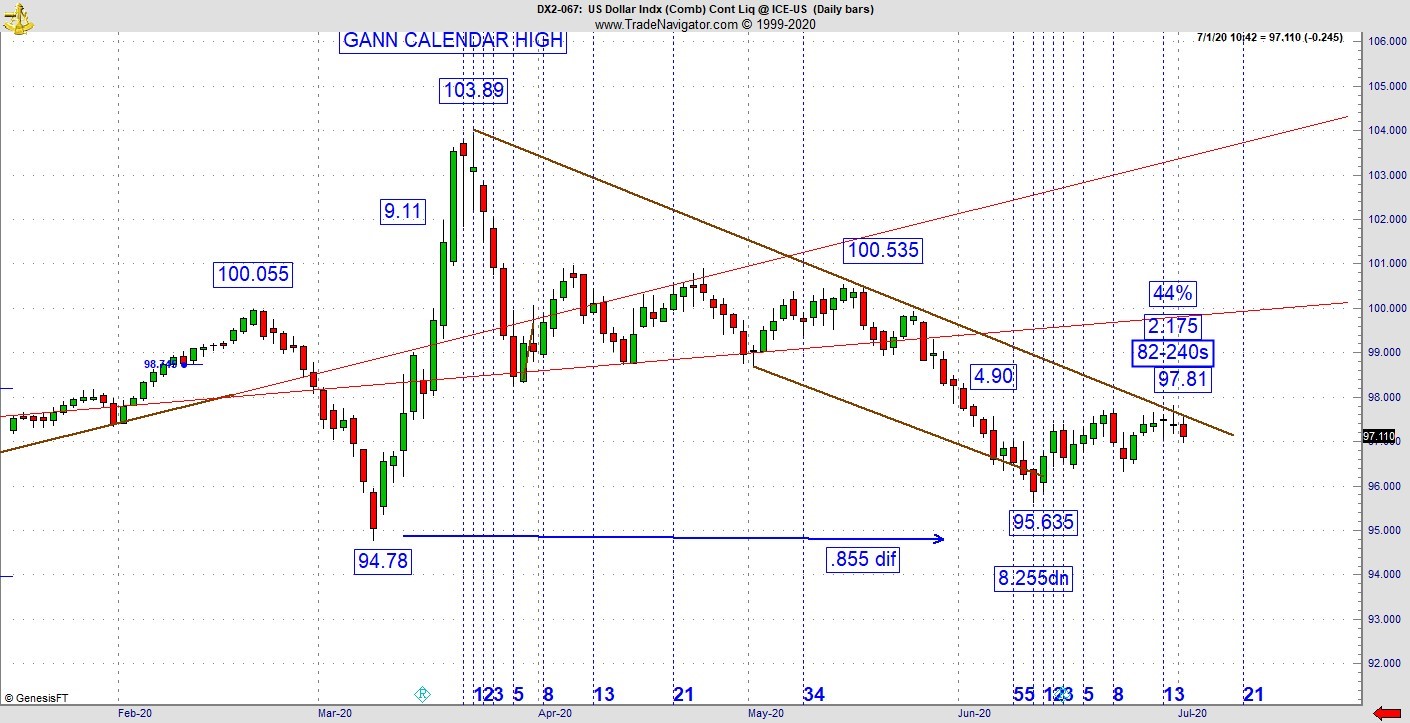With historic market movements likely, traders need to keep losses to a minimum, writes Jeff Greenblatt.
The U.S. Dollar Index rallied right up to the descending trend line and stalled. On a daily bar the bears are in the process of getting the upper hand. The Kairos reading can’t be seen on this chart (below). All you need to know is the high of 97.81 lines up on a 240-minute chart at 82 bars. Lots of smart people are calling for the dollar to collapse. Normally, when lots of people are looking for something to happen, the exact opposite does materialize. In this case most people aren’t looking at the dollar, only the people who know what they are doing.

You already know in monetary terms why the greenback is way off the high. I gave you the 144-month cycle high right after it happened. Putting that aside, you can’t print trillions and expect the currency to maintain its value. But let's put that aside. Look around you. Do you see any semblance of what made our economy great in the first place? The economy was in trouble before 2020 happened. The President likes to tell us it was the greatest economy ever.
No, it wasn’t. Let's be clear about this. The United States was the only major power without infrastructure damage after World War II. As a creditor nation, we rebuilt the entire world. That’s what created the most prosperous era in our history, which was the 1950s. The Elliott Wave people tell you grand super cycle wave 3 peaked in 1966. The reason we faltered was social unrest of the 1960s and then the oil crisis of the 1970s. Fast forward to the 1980s, President Reagan really did build a great economy based on the technology of electronic warfare. In those days I worked as a recruiter for programmers and engineers in Los Angeles. Aerospace companies routinely paid $10,000 to $20,000 to pluck the talent from the opposition. The public saw the result during the first Gulf War. California was never better.
Now we are the opposite. The United States is the greatest debtor nation in the history of the world and wherever you look, someone is telling us the revolution is on. Now we are back on lockdown and I warned you repeatedly over the past three months there was no recovery. There never will be one until the politicians decide to leave businesses alone.
I’m very concerned about what will happen to all the unemployed as the stimulus and unemployment money starts to run dry this month. For many, they got a 90-day forbearance on their car loans. That's also expiring this month.
As far as the U.S. Dollar is concerned, it's not a matter of if but when it finally collapses.
The stock market? That’s more complex. The Federal Reserve continues to prop it up, but it is doing so with a greenback that is roughly 6% less valuable than it was when the stock market bottomed. This is what a hyperinflationary depression looks like. By the time the business channels tell us, it will be too late. We are there now. Consumers don’t realize it until they go the supermarket to find groceries cost just a little more. We don’t know what else would cost more because most of it is closed.
By the way, we are about to find out what the NBA and Stanley Cup playoffs will look like without the energy from the fans. Unless people are allowed back in the building, sports is not going to survive. Let that sink in.
Let's change gears and talk about some of the ways you can avoid losing money at trading. Obviously, you need to know when you have an edge against those on the other side of your trade. But you also need to trade in relation to the size of your bankroll. You will need to take trades in psychologically uncomfortable places on a chart. That’s usually where it appears risk is great. But if you have a fear program about losing, it will hamper you from pushing the button when you need to. For some of you, that is going to mean trading the E-micro as opposed to the E-mini stock index futures. You must not risk too much of your bankroll on any given trade. The corollary is being able to take a loss. One must look at a losing trade the same way a field goal kicker shakes off an important miss. A successful trader has to come to terms there will be losing trades and losing days. If you lose small you will survive to trade another day.
There are so many ways to lose money at trading. When you lose, if you can’t make a mental note of why and how you lost; keep a journal. What you are likely to find is there is a pattern to your losses. Many traders lose money the exact same way time and time again. Monitor your emotions and work at impulse control. Do you find yourself chasing breakouts because you are afraid the train is leaving the station without you? The best trades are when you know what your edge is, but others haven’t figured it out. What you want to do is get on board the wave before or just as it starts to move. To pull that off successfully, it requires lots of practice. More practice than most are willing to do. How much time have you spent on a simulator? Some of you should be practicing on a simulator for weeks. That’s not a popular suggestion but lots of people start out well but inevitably run into a pattern they don’t understand or haven’t seen before and can give back days or weeks of gains in a short period of time.
Professional athletes always warm up and in baseball they take batting practice. Larry Bird used to take a thousand jump shots every day for years. Why do you think he made the winning shot look so routine?
Trading isn’t the same, but our approach must be similar. If you trade intraday, study the pattern early in the morning and work at getting into the flow of the day before you try to take any trade. In summary, a trader’s mind is as valuable as a batter’s eye or a placekicker’s mechanics. No trade can be better than a bad one. Always be prepared and get warmed up each trading day.
If you want more information, go to: Lucaswaveinternational.com and sign up for the free newsletter.





















